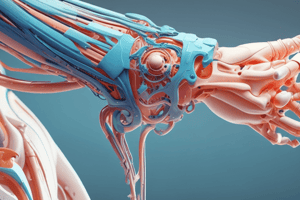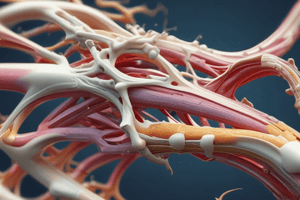Podcast
Questions and Answers
What is untrue of arthrokinematic motion?
What is untrue of arthrokinematic motion?
- The fundamental movements are roll, slide, and spin
- Motions generally obey the convex-concave rule
- Spinning is the primary mechanism for joint rotation when the longitudinal axis of the moving bone intersects the surface of its articular mate at right angles.
- Is described by a moving bone on a stationary bone relative to the three cardinal planes. (correct)
Please match each term with its definition
Please match each term with its definition
Kinematics = Motion of a body without regard to the forces or torques that may produce the motion Kinetics = Describes the effect of forces on the body Translation = Linear motion in which all parts of a rigid body move parallel to and in the same direction as every other part of the body Curvilinear motion = All parts of a rigid body move along a curved line
Select all that are example of INTERNAL Forces
Select all that are example of INTERNAL Forces
- Muscle contraction (correct)
- Force on a limb due to Gravity
- Joint reaction force (correct)
- mass of a limb
Select all examples of EXTERNAL forces
Select all examples of EXTERNAL forces
Match each term with the most appropriate answer regarding levers.
Match each term with the most appropriate answer regarding levers.
Inertia is proportional to the mass of the object, how is "mass moment of inertia" different from "mass"?
Inertia is proportional to the mass of the object, how is "mass moment of inertia" different from "mass"?
Select all true statements regarding Newton's 1st Law
Select all true statements regarding Newton's 1st Law
Which is NOT TRUE regarding the Impulse-Momentum relationship?
Which is NOT TRUE regarding the Impulse-Momentum relationship?
Select all true statements regarding Newton's 2nd Law
Select all true statements regarding Newton's 2nd Law
Select all true statements regarding Newton's 3rd Law
Select all true statements regarding Newton's 3rd Law
Flashcards
Kinematics
Kinematics
Motion of a body without regard to the forces or torques that may produce the motion.
Kinetics
Kinetics
Describes the effect of forces on the body.
Translation
Translation
Linear motion in which all parts of a rigid body move parallel to and in the same direction as every other part of the body.
Curvilinear motion
Curvilinear motion
Signup and view all the flashcards
Rotation
Rotation
Signup and view all the flashcards
Arthrokinematic motion
Arthrokinematic motion
Signup and view all the flashcards
Osteokinematic motion
Osteokinematic motion
Signup and view all the flashcards
Roll
Roll
Signup and view all the flashcards
Slide
Slide
Signup and view all the flashcards
Spin
Spin
Signup and view all the flashcards
External force
External force
Signup and view all the flashcards
Internal force
Internal force
Signup and view all the flashcards
Inertia
Inertia
Signup and view all the flashcards
Moment of Inertia
Moment of Inertia
Signup and view all the flashcards
Lever
Lever
Signup and view all the flashcards
Mechanical advantage of the muscle
Mechanical advantage of the muscle
Signup and view all the flashcards
Mechanical advantage of the external resistance
Mechanical advantage of the external resistance
Signup and view all the flashcards
2nd class lever
2nd class lever
Signup and view all the flashcards
3rd class lever
3rd class lever
Signup and view all the flashcards
Newton's First Law
Newton's First Law
Signup and view all the flashcards
Newton's Second Law
Newton's Second Law
Signup and view all the flashcards
Newton's Third Law
Newton's Third Law
Signup and view all the flashcards
Impulse-Momentum Relationship
Impulse-Momentum Relationship
Signup and view all the flashcards
Momentum
Momentum
Signup and view all the flashcards
Impulse
Impulse
Signup and view all the flashcards
Static Equilibrium
Static Equilibrium
Signup and view all the flashcards
Dynamic Equilibrium
Dynamic Equilibrium
Signup and view all the flashcards
Ground Reaction Force
Ground Reaction Force
Signup and view all the flashcards
Muscle Force
Muscle Force
Signup and view all the flashcards
Joint Reaction Force
Joint Reaction Force
Signup and view all the flashcards
Study Notes
Arthrokinematic Motion
- Arthrokinematic motion describes the movement of one bone relative to another.
- The fundamental movements are roll, slide, and spin.
- Incorrect statement: Arthrokinematic motion isn't described by a moving bone on a stationary bone relative to the three cardinal planes.
Kinematics and Kinetics
- Kinematics describes the motion of a body without considering the forces causing it.
- Kinetics describes the effect of forces on a body's motion.
- Translation is linear motion where all parts of a rigid body move parallel and in the same direction.
- Curvilinear motion is where all parts of a rigid body move along a curved line.
Internal Forces
- Muscle contraction is an example of an internal force.
- Joint reaction force is an internal force.
External Forces
- Forces on a limb due to gravity are external forces.
- Resistance from another person during a manual muscle test is an external force.
- Resistance bands during exercise are external forces.
Levers
- A lever is a simple machine.
- Mechanical advantage of a muscle is the ratio of the internal moment arm to the external moment arm.
- Mechanical advantage of the external resistance is the ratio of the external moment arm to the internal moment arm.
- The most common lever class in the human body is the third-class lever.
- A 2nd-class lever will have the muscle or internal force have more leverage than the external force
Mass Moment of Inertia
- Mass moment of inertia measures how difficult it is to change the rotational state of an object.
- It depends on the distribution of mass and the axis of rotation.
Newton's First Law
- It states that a body will remain in its current state of motion (either at rest or moving with constant velocity) unless acted upon by an unbalanced force.
- A body is in static equilibrium when all linear and rotational velocities are zero.
- A body is in dynamic equilibrium when all linear and rotational velocities are constant.
Newton's Second Law
- States that the acceleration of an object is directly proportional to the net force acting on it and inversely proportional to its mass.
- Linear acceleration is directly proportional to the force causing it.
- Angular acceleration is proportional to torque and inversely proportional to the mass moment of inertia.
Newton's Third Law
- This Law states that for every action, there is an equal and opposite reaction.
- For example: a ground reaction force on a person during gait.
Impulse-Momentum Relationship
- Impulse is the product of force and time.
- Momentum is the product of mass and velocity.
- The impulse-momentum relationship states that the change in momentum of an object is equal to the impulse applied to it.
- Following through with a baseball swing is based on this relationship.
Studying That Suits You
Use AI to generate personalized quizzes and flashcards to suit your learning preferences.




